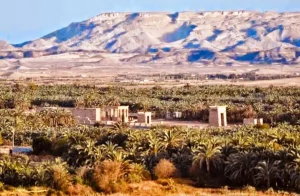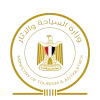Kharga Oasis

Kharga Oasis
At First, El Kharga Oasis is one of the most wonderful sites in the world, especially at sunset. So, It is a green island in the middle of a yellow ocean of sand. El Kharga is the capital of New Valley Governorate in Egypt that hosted inhabitants since prehistoric times. Furthermore, it is still at present the most populated oasis of Egypt. In the Arabic language, Kharga means “outside”. It is a wide depression that extends over an area of 220 km from north to south and comprises the whole Southern Egypt except for the part beside the Red Sea. El Kharga is located 232 km South of Asyut, 610 km South of Cairo, and to the west of the Nile Valley. Egypt international border with Libya located on the Western edge of the governorate of Al Wadi Al Gadeed.
History of Kharga Oasis
In August 2010, the Egyptian-American archaeological mission discovered the ruins of the most ancient residential area. It goes back to the second intermediate period. These ruins reflect that Kharga was major administrative and services body. Further, it is an important transit point for the desert caravans. The mission has found the ruins of some huge buildings, passageways, and a large bread bakery. His date back to the Middle Kingdom. The 12th dynasty was a transition period in the Egyptian history. In that period, the Hyksos had control over Northern Egypt and Pharos ruled over Southern Egypt and the Nubia.
In addition, It was always considering the Southern and Western Gate of Egypt. So, It connected Egypt to Southern Africa through the famous Forty Days Road. Scholars believe that this civilization in this area went on until the new Kingdom (1569-1081BC). However, the area flourished during the 13th dynasty, the second intermediate period (1664-1569 BC), and the 17th dynasty (1600- 1569 BC).
Greek historian Herodotus mentioned that Campuses sent a huge army from Thebes to destroy the Oracle Temple of Amon at Siwa. Moreover, The army reached El-Kharga and continued towards Siwa. However, the campaign vanished and no one can tell what really happened, even today!. Maybe the Persian army lost in the desert and sunk in the Great Sea of Sand.
During the third and fourth century AD, a lot of Egyptian Christians fled to Kharga Oasis and the surrounding areas to escape from the Romans who persecuted the Copts of Egypt because of their Christian beliefs and religion. Equally important, the Copts lived in peace in the Kharga Oasis and left remarkable monuments like the cemetery of Bagawat.
El Kharga Oasis Today
As a capital of the new Valley Governorate it is the most important part of the oasis in the Western Desert. Although the New Valley governorate occupies around one third of the whole land of Egypt, it contains the least population density in the whole nation with around 250,000 inhabitants nowadays. Be know that the reason behind this is that the vast deserts surrounding the area. Tourism isn’t a major activity for the people living in Kharga. Most of them work in normal jobs like the other cities of Egypt. At the same time, it also hosts one of the largest phosphates mime in the world in the area of Abu Tartour. Kharga connected to the Nile Valley with a set of roads. The first one goes from Asyut to the Kharga while the second goes from kharga to Dkahla and Farafra.
El-Kharga is famous for the large number of palm-trees, pigeon-houses, fields, monuments, wells, artisans, and honey-colored hills. Chlorine or other chemicals scattered and completely unpolluted pure springs and natural wells in several locations in the Oasis. Local people are very kind and welcome the visitors. There are lots of things you can do there like visiting historical websites, riding camels, sleeping under the stars, or just relaxing between the high palm-trees. Life there is simple, but extremely satisfying!
Temple of Hibis
Temple is located approximately one km north of Kharga. Moreover, it represents different stages of the Egyptian history so it is very important. Originally, it constructed during the 26th dynasty for worshipping the holy triad (Amun-Mut-Khonsu). Equally important, the work construction started under the rule of Iris then Ahmos II and completed during the Hyksos occupation of Egypt specifically in the reign of Darius I (522 BC). The temple starts from the East with the sacred lake and the ports. Later on 69 AD, the Roman emperor Galba built a Roman gate there. Afterwards, there is the rams’ passageway that leads to the major gate of the temple. Sanctum stands at the end of the temple with its remarkable unique inscriptions.
Cemetery of Bagawat
Cemetery of Bagawat is located three km north of Kharga behind the Temple of Hibis, occupies a surface area of 10,000 squares. His name was from its style of architecture as most of the tombs there were constructed in the form of domes, or “Qubwat” in Arabic which transformed afterwards into Bagawat. Also, it dates back from the second to the seventh century AD when the Christians escaped from Northern Egypt resorted to Kharga Oasis. Likewise, it contains 236 tombs constructed as small domed chapels with a central church in the middle, which is considered one of the most ancient Coptic Churches of Egypt.
Exodus Tomb is the most important tombwhich represents the Pharos forcing the Israelis to go out of the country; another one called peace that contains reliefs of Jacob, the Virgin Mary, Saint Paul, and Saint Takla. Other tombs display many colorful Coptic inscriptions and writings that demonstrate the Coptic life during this period.
Ghweita temple
Ghweita temple means “fortress of deep springs” is located 25 km south of the city of Kharga. This temple built during the Hyksos occupation by Darius I for worshipping the holy triad (Amun-Mut-Khonsu). It also enlarged in the Ptolemaic era between the 3rd and 1st century BC. In addition, the Temple now includes a hall with 8 huge columns, a hypostyle hall, and a sanctuary.
Qaser Al Zayyan Temple
Qaser Alzayyan temple is located 5 km south of Temple of Ghweita and there is an asphalt road that links between the two temples.During the period of the Roman emperor Pius in the 2nd century AD, they constructed and enlarged it. Afterward, this temple dedicated to the cult of Amun Ra of Hibis. Finally, it contains a sanctuary made out of white limestone blocks and many mud brick side chambers all around it.
Dush Temple
First, this area corresponds to the Ptolemaic and Roman settlement of Kysis; and it is located near the oasis of Paris and about 120 km south of Kharga. Second, it was important in the old world as it granted the control of several Caravan routs in the Roman and Ptolemaic times. There are two Roman fortress and two temples. Likewise, the major temple was made out of limestone blocks during the rule of Domitian (81 – 96 AD) and enlarged by many of his successors and it was dedicated to the worship of Isis. Uniquely, the French institution of oriental archeology started excavations in 1976. Following, they found many golden items and interesting monuments.
The Museum of Antiquities of Kharga
Finally, the Museum of Al Kharga hosts a lot of the items from all over the archeological sites of the governorate. Uniquely, it includes a statue of Horus, some Pharonic reliefs, and a collection of Coptic pottery. Be know that the museum is open daily from 9 AM till 3 PM.





